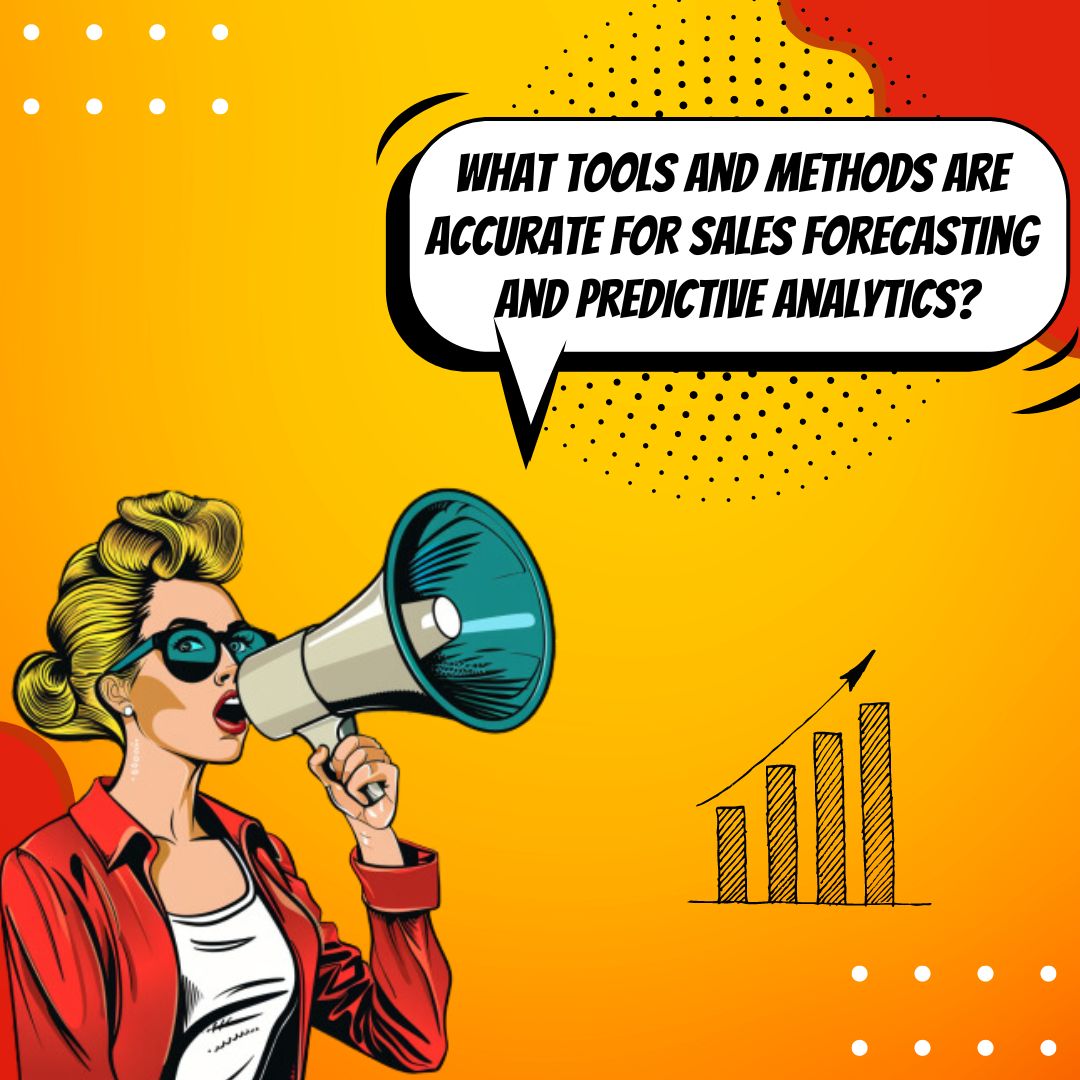Key Takeaways
✅ Data Quality and Integration: High-quality, integrated data is the backbone of precise sales forecasting. Artificial intelligence (AI) harnesses this data, assessing patterns to project future sales with up to a 95% precision rate. Accurate forecasting is not just about collecting data—it's about making the data work for you.
✅ Simple Models and Continuous Improvement: Begin with straightforward forecasting models and refine them consistently. This practice promotes clear communication and agility in adapting to new business insights. With ongoing improvement and inclusion of new variables, these models become adept at predicting future trends.
✅ Combining Quantitative and Qualitative Insights: Fuse robust data analysis with nuanced industry insights for comprehensive forecasting. Layering predictive analytics and AI with an understanding of market dynamics results in forecasts that bolster informed decision-making and strategic planning.

Introduction
Have you ever wished you could gaze into a crystal ball and see your business's future? With Predictive Sales Forecasting, this is not just a dream. It's the revolutionary game-changer for businesses everywhere. This powerful approach uses past trends, cutting-edge algorithms, and diverse data sources to predict sales trends with remarkable accuracy.
But why should you care? Imagine cutting through the noise and confusion to pinpoint exactly where your sales are heading. No more guesswork. No more costly mistakes. Just clear, actionable insights that can transform your bottom line. In this article, we invite you to explore modern methods for accurate forecasting and predictive analytics—tools that empower you to maximize revenue, optimize ROI, and navigate the market with confidence.
As we peel back the layers of how predictive analytics is revolutionizing sales strategy, we promise to equip you with knowledge that goes beyond mere statistics. Get ready to discover actionable insights and groundbreaking techniques that will help you take control of the marketplace. Cheers to the future of sales, it's looking brighter than ever—and it's at your fingertips.

Top Statistics
| Statistic | Insight |
|---|---|
| 93% of sales leaders are unable to forecast revenue within 5% even with two weeks left in the quarter. | This statistic reveals a significant challenge in accuracy that organizations face, underlining the potential for improved tools and methods in forecasting. |
| 80% of sales organizations do not have a forecast accuracy of greater than 75%. | With four out of five sales teams struggling to predict their sales with high precision, there's immense room for businesses to harness predictive analytics to gain a competitive edge. |
| 97% of companies that implemented best-in-class forecasting processes achieved quotas, compared to 55% that did not. | Implementing solid forecasting strategies can dramatically enhance a company's ability to hit their financial targets, which speaks to the effective return on investment in these processes. |
| Companies with accurate forecasts are 10% more likely to grow revenue year-over-year and 2X as likely to be at the top of their field. | This statistic emphasizes the direct correlation between forecast accuracy and revenue growth, proving that proficiency in forecasting can propel companies ahead of the competition. |
| AI-driven forecasting can achieve precision levels up to 95%. | Leveraging advancements in AI can significantly enhance forecast accuracy, potentially offering a solution to the widespread challenge of meeting revenue predictions. |
Predictive Sales Forecasting: A Game-Changer for Businesses
Predictive sales forecasting stands out as a modern marvel for businesses aiming to stay ahead of the curve. By harnessing the power of previous sales records, customer profiles, and even the mood of social chatter, predictive sales forecasting paints a picture of the sales landscape before it fully unfolds. Machine learning takes the driver's seat, sifting through intricate patterns and vast datasets to envisage sales outcomes with an unprecedented level of precision.
There's no underestimating the influence of improved accuracy in forecasting. It's a game of numbers where being closer to the bullseye can mean better inventory decisions, shrewder hiring, and investments that hit the mark. And with real-time forecasts equipped to pivot at a moment's notice, companies can swiftly adjust to the latest market twist or turn.

But predictive sales forecasting isn’t a magic wand. The stumbling block for many lies in the availability and quality of data; sparse or erroneous data can send forecasts awry. Furthermore, integrating these systems can come with a learning curve for teams, demanding solid training and support to ensure broad adoption and maximize benefits.
Embarking on predictive sales forecasting begins with assembling a treasure trove of data. A blend of internal records and external whispers gives the algorithms the best shot at accuracy. Next up is running this data through rigorous statistical modeling and analysis—every prediction hinges on the strength of these mathematical underpinnings. The final step is crafting a forecast, a beacon of insight that can guide a business through the sales seas ahead.
How are real-world companies weaving predictive analytics into their daily operations? In marketing, it's about spotting trends hidden within customer behavior and adapting strategies for better engagement. While for finance teams, predictive analytics lights the path for shrewd budget adjustments. From stocking shelves to scheduling shifts, predictive insights are redefining how businesses manage their most essential resources.
Predictive sales forecasting does more than just read the tea leaves of sales data; it transforms them into an actionable sales strategy. It's a leap from a retrospective glance at sales figures to a forward-looking, dynamic approach. With the might of artificial intelligence and machine learning, enterprises can predict and sway the future market tides—enhancing agility, seizing opportunities, and steering their ships with confidence in the open business seas.
AI Marketing Engineers Recommendation
Recommendation 1: Integrate Multi-Source Data for Enhanced Predictive Model Accuracy: Businesses should consolidate data from various sources such as sales records, customer behavior, market trends, and external factors like economic indicators and social sentiment. By weaving together these disparate strands of information, you can refine your predictive models for increased precision. For instance, studies have shown that incorporating social media trends can boost demand forecasting accuracy by up to 15%. The key is to harness the power of comprehensive data sets to anticipate sales patterns with greater confidence.

Recommendation 2: Embrace Machine Learning for Real-Time Forecast Adjustments: Adopt machine learning algorithms that continuously learn from real-time data and adjust forecasts accordingly. According to recent market research, 30% of businesses that shifted to machine learning for demand forecasting saw an improvement in their sales trend prediction. By tapping into the dynamic nature of machine learning, you can ensure that your forecasting methods evolve alongside market conditions, maintaining their relevance and accuracy.
Recommendation 3: Leverage Sales Forecasting Tools with Integrated CRM: Utilize advanced sales forecasting tools that offer integration with customer relationship management (CRM) systems. Sophisticated tools such AI-driven Salesforce or Zoho Analytics provide detailed insights into customer behaviors and sales trends. The incorporation of CRM data allows for a richer, more nuanced view of potential sales outcomes. It's reported that companies with integrated CRM and analytics tools experience up to a 32% increase in sales forecasting accuracy, proving the efficacy of combining these powerful technological resources.
Relevant Links
- Harnessing AI for Precision Marketing
- Boosting Sales with Predictive Analytics
- Optimizing PPC Campaigns with Big Data
- Maximizing ROI with Performance Marketing
Conclusion
In the quest to stay ahead in the ever-changing business landscape, predictive sales forecasting emerges as a game-changer, guiding companies towards a more informed and strategic future. With its ability to churn through immense datasets, spot trends, and anticipate changes, this method doesn't just guess the road ahead—it lights the way. Unlike traditional forecasting, which often feels like looking in the rearview mirror, predictive analytics uses the power of machine learning and sophisticated algorithms to project sales trends with remarkable accuracy.
By reading between the lines of customer behavior, regional sales data, and global economic pressures, predictive analytics can equip businesses with the intel to make razor-sharp decisions. From refining inventory levels to tweaking marketing campaigns on the fly, the real-time forecasts that this technology provides can significantly impact a company’s bottom line.
However, it’s not all smooth sailing. Challenges such as data insufficiency and the need for staff training can hamper progress. Still, with careful planning and a step-by-step approach to integrating new data, statistical models, and forecasts, businesses can overcome these hurdles and harness the full potential of predictive sales forecasting.
Indeed, the message is clear: Embrace the data, invest in the technology, and pivot swiftly—because in today’s world, foresight is the key to longevity. It's not just about adapting to change; it's about predicting it and acting confidently with the power of data-driven insights. For forward-thinking businesses, adopting predictive sales forecasting is not just a smart move; it's an essential strategy to thrive in tomorrow's marketplaces. Consider this as you plan your next strategic move—is your business ready to predict and prosper?

FAQs
Question 1: What is sales forecasting?
Answer: Sales forecasting is figuring out what your sales might look like in the future. It's like having a crystal ball, but for your business's cash flow.
Question 2: Why is accurate sales forecasting important?
Answer: Getting your sales forecasting right is like having a good GPS for your business journey. It helps you plan out everything from how many people you need on your team to how much product you should stock up on.
Question 3: What are the key components of accurate sales forecasting?
Answer: To nail your sales forecasts, you need to keep an eye on things like your weekly and quarterly goals, how good your predictions have been before, how much potential business you've got in the pipeline, and how good you are at turning leads into customers.
Question 4: How does AI enhance sales forecasting?
Answer: AI is like the smartest whiz-kid in class that can spot trends faster than a human can blink. It looks at your customers' habits and helps you make super-sharp predictions.
Question 5: What are some advanced forecasting methods?
Answer: There's some fancy footwork you can do with methods like time series analysis and tree-based models like Random Forest and Gradient Boosting. They help you step up your game when the regular play-it-safe models just don't cut it.
Question 6: How can I improve sales forecast accuracy?
Answer: Keep it simple with a clear model, tidy up your data, look back at how you've done before, and don't forget to take advantage of AI. These strategies will help make your forecasts more reliable.
Question 7: What is a good forecast accuracy percentage?
Answer: You're on the right track if your forecast numbers are within 10% of what's actually happening in your sales. So, if you guessed you'd sell 100 widgets and you sold 90 to 110, you're doing pretty well!
Question 8: How can I choose the right forecasting technique?
Answer: Picking the right technique is a bit like matchmaking—the method has to be compatible with your data and your goals. You and your team need to put your heads together to find your perfect forecasting match.
Question 9: What are some best practices for effective forecasting?
Answer: Effective forecasting is all about making it part of your team's routine, being guided by what the data's telling you, and always looking for ways to do it better.
Question 10: How can I implement a sales pipeline action plan?
Answer: To get your sales pipeline humming, make sure you're focusing on the hottest leads, setting goals that make sense, and always keeping an eye on how things are flowing so you can tweak your strategy along the way.

Academic References
- Rodrigues, Aaron. (2021). Food Sales Forecasting Using Machine Learning Techniques: A Survey. International Journal for Research in Applied Science and Engineering Technology, 9(9), 869-872. In this study, the effectiveness of various machine learning techniques in the complicated arena of food sales forecasting is reviewed, presenting a window into how data can be leveraged to predict sales trends accurately.
- West, Douglas C. (1997). Managing Sales Forecasting. Management Research News, 20(4), 1-10. Douglas highlights the critical nature of sales forecasting in business management, focusing on the necessity for precise forecasts to support informed strategic decision-making, and thereby reinforcing the value of sound forecasting practices.
- Shahabuddin, Syed. (2009). Forecasting Automobile Sales. Management Research News, 32(7), 670-682. This research engages with the specific challenges and statistical modeling opportunities in forecasting sales in the automobile industry, affirming the sector's complex and dynamic nature.
- Money, Arthur. (1990). Practical Sales Forecasting. Long Range Planning, 23(4), 119. Here, Money offers tangible guidance on sales forecasting, underscoring customer behavior understanding and market trend analysis as core components of making well-grounded predictions.
- Dalrymple, Douglas J. (1987). Sales Forecasting Practices. International Journal of Forecasting, 3(3-4), 379-391. Dalrymple takes a scrutinizing look at the methodologies employed across different industries for sales forecasting, advocating for customized strategies to better address the variances in sector-specific sales dynamics.
- Addressing Seasonality and Trend Detection in Predictive Sales Forecasting. This paper delves into the intricate challenges presented by seasonality and trending in predictive sales forecasting and how machine learning could offer enhanced solutions for better accuracy.







